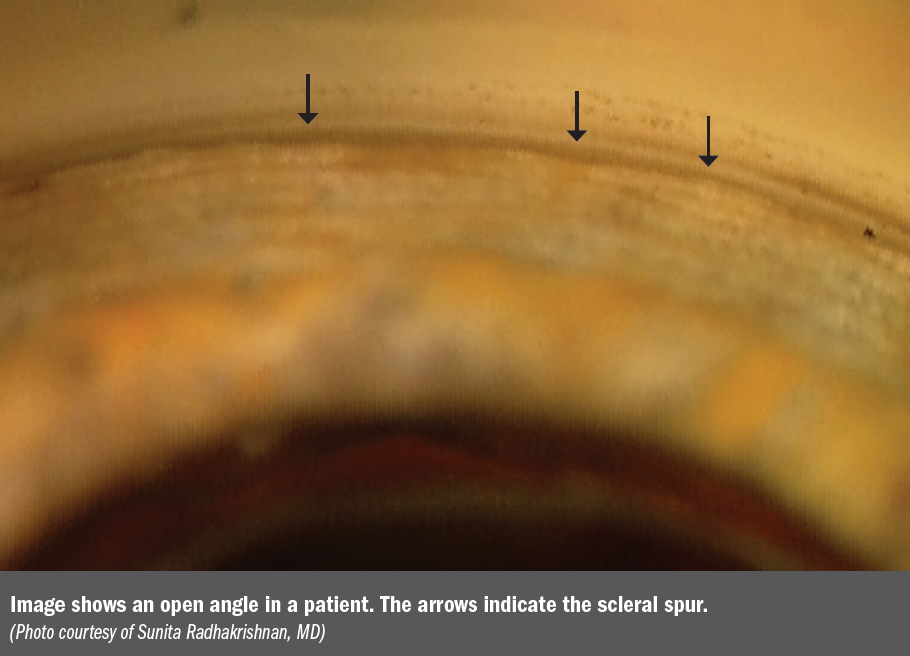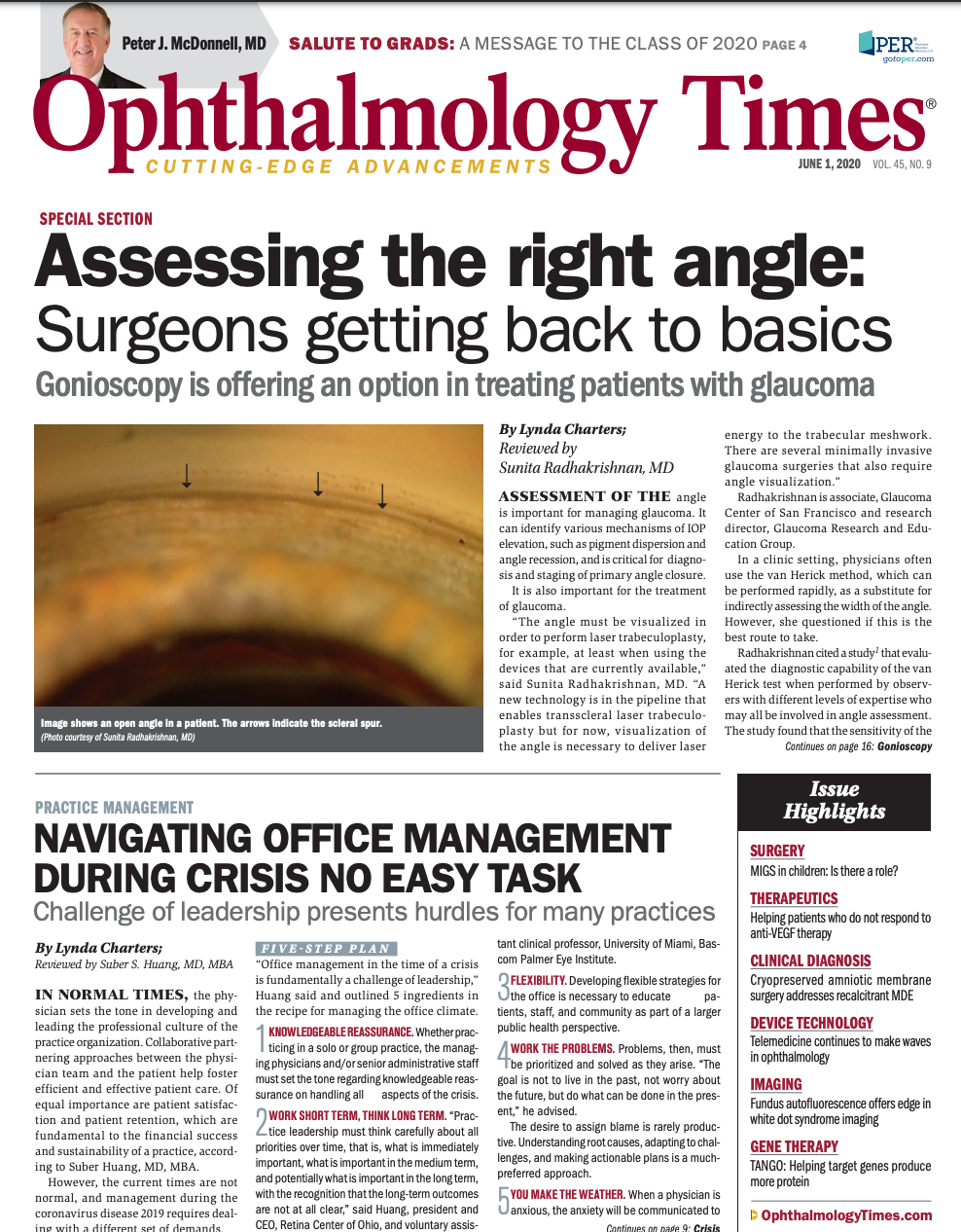Publication
Article
Digital Edition
Assessing the right angle: Surgeons getting back to basics
Author(s):

Gonioscopy is offering an option in treating patients with glaucoma.
This article was reviewed by Sunita Radhakrishnan, MD
Assessment of the angle is important for managing glaucoma. It can identify various mechanisms of IOP elevation, such as pigment dispersion and angle recession, and is critical for diagnosis and staging of primary angle closure.
It is also important for the treatment of glaucoma.
“The angle must be visualized in order to perform laser trabeculoplasty, for example, at least when using the devices that are currently available,” said Sunita Radhakrishnan, MD. “A new technology is in the pipeline that enables transscleral laser trabeculoplasty but for now, visualization of the angle is necessary to deliver laser energy to the trabecular meshwork. There are several minimally invasive glaucoma surgeries that also require angle visualization.”
Radhakrishnan is associate, Glaucoma Center of San Francisco and research director, Glaucoma Research and Education Group.
In a clinic setting, physicians often use the van Herick method, which can be performed rapidly, as a substitute for indirectly assessing the width of the angle. However, she questioned if this is the best route to take.
Radhakrishnan cited a study1 that evaluated the diagnostic capability of the van Herick test when performed by observers with different levels of expertise who may all be involved in angle assessment.
The study found that the sensitivity of the van Herick test to detect gonioscopic angle closure ranged from 58% among technicians to 79% among residents.
“This is low sensitivity when screening patients for angle closure,” she noted.
A different study2 addressed risk factors associated with misdiagnosis when using the van Herick test to detect angle closure.
Indirect assessment using the van Herick test can not only miss angle closure but it also cannot detect angle pathology that could be present in patients with a deep anterior chamber and no obvious glaucoma risk factors.
A classic example, Radhakrishnan said, is angle recession in a patient with an old and forgotten ocular injury.
These studies underscore the importance of directly viewing the angle structures with gonioscopy. This test provides a 360° assessment of the angle configuration.
“The observer can perform indentation in angle closure and identify peripheral anterior synechiae as well as plateau configuration. We can also detect various other causes of elevated pressure,” Radhakrishnan said.
Gonioscopy candidates
In her glaucoma practice, Radhakrishnan performs gonioscopy on every patient. However, there is an argument that gonioscopy should be performed even in patients who do not have known risk factors for glaucoma.
“This is a strategy to opportunistically screen for angle-closure,” she pointed out. It is also important to periodically repeat gonioscopy in phakic patients because even those in whom the angle is open at baseline can ultimately develop angle-closure as a result of lens thickening over time.
What to look for
When performing gonioscopy, the main landmark and usually the most easily recognized one is the scleral spur, which lies between the pigmented trabecular meshwork and pigmented ciliary body.
Radhakrishnan said when she performs gonioscopy, she first locates the scleral spur. If it is not visible in the first quadrant examined, then she looks in another quadrant in which the trabecular meshwork pigmentation may be more prominent.
If the scleral spur still is not visible, Radhakrishnan suggests tilting the gonio lens slightly; if the spur remains undetectable, then she performs indentation gonioscopy to differentiate appositional from synechial angle-closure.
Pale trabecular meshwork may increase the difficulty in visualizing the scleral spur. In such patients, she recommends starting at the Schwalbe’s line (which can be identified with the corneal wedge technique) and working backward from there.
Schwalbe’s line often is pigmented, especially in the inferior quadrant, and can be mistaken for the trabecular meshwork so care should be taken in interpreting the angle status to avoid misclassifying a closed angle as open.
When gonioscopy is performed in the operating room, different steps are necessary from those performed in the clinic.
Radhakrishnan referred residents, fellows, and novice surgeons to the American Academy of Ophthalmology website (www.aao.org) for tips on gonioscopy in the operating room.
“The main consideration is that the microscope illumination changes from coaxial for cataract surgery to being directed along the iris plane and onto the angle,” she explained. “The microscope is tilted about 30° toward you and the patient’s head is turned about 30° to 40° away from you. This increases the working distance by several inches, which takes a little time to become accustomed to.”
Another difference from the examination performed in the clinic is that a surgical (direct) gonio lens is used in contrast to the indirect lens in clinic. A coupling agent is used on the cornea as well as adequate viscoelastic in the anterior chamber.
She prefers Healon GV (Johnson & Johnson Vision), and noted that the product name is now Healon GV Pro to indicate a change in the formulation. Some recommendations that have been suggested for replacing Healon GV are Healon 5 and ProVisc (Alcon), Dr. Radhakrishnan recounted.
Gonioscopy alternatives
Despite being the best way to directly evaluate the angle, gonioscopy does have limitations. “It is a subjective procedure, and it needs a slit-lamp as well as a highly trained observer,” she said and noted that angle imaging is an alternative that overcomes some of the limitations of gonioscopy.
Cross-sectional imaging of the angle can be performed with optical coherence tomography (OCT) and ultrasound biomicroscopy (UBM). The former is a noncontact technology that facilitates assessment in the dark and the entire anterior chamber is visualized in one scan.
The disadvantage is that visualization of structures behind the iris is not possible.
OCT provides options to image the angle. The dedicated anterior-segment OCT (Visante, Zeiss) is best for visualizing the angle recess, but is not widely available. Angle imaging can also be done with a retinal OCT device, but the scleral penetration is not as good as with the Visante.
She uses a Visante OCT in her practice and also has access to Cirrus OCT (Carl Zeiss Meditec) with an anterior-segment external lens kit that can be attached to the machine to obtain images of the angle.
UBM provides visualization of the angle structures in front of and behind the iris. However, traditional UBM with an immersion bath is time-consuming. A trained ultrasound technician is needed. The scleral spur is the key landmark to locate.
Radhakrishnan uses imaging as an adjunct to gonioscopy to identify primary versus secondary angle-closure mechanisms.
However, imaging can also be a substitute for gonioscopy for patients who cannot tolerate a contact procedure or if corneal pathology does not permit visualization of the angle by gonioscopy.
She also relies on imaging to educate patients about their disease.
“OCT is my first-line imaging device because it is easy to use and comfortable for patients,” Radhakrishnan said.
Ultrasound biomicroscopy is reserved for viewing structures posterior to the iris and for evaluation of plateau configuration.
“I would like to encourage clinicians to perform gonioscopy more often,” she concluded. “Know the landmarks and use imaging technologies as adjuncts to gonioscopy. Remember that gonioscopy performed in the operating room is different from that in clinic.”
Sunita Radhakrishnan, MD
E: frontdesk@glaucomasf.com
Dr. Radhakrishnan has no financial interest in this subject matter.
References:
1. AM J Ophthalmol. doi:10.1016/j.ajo.2018.07.026
2. Ophthalmology Glaucoma, 2018:108-114





